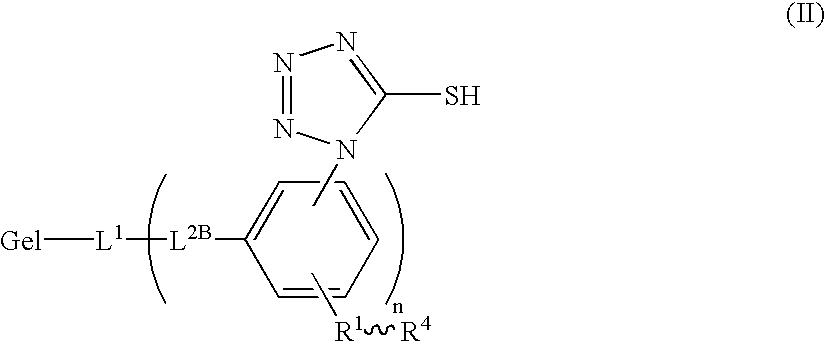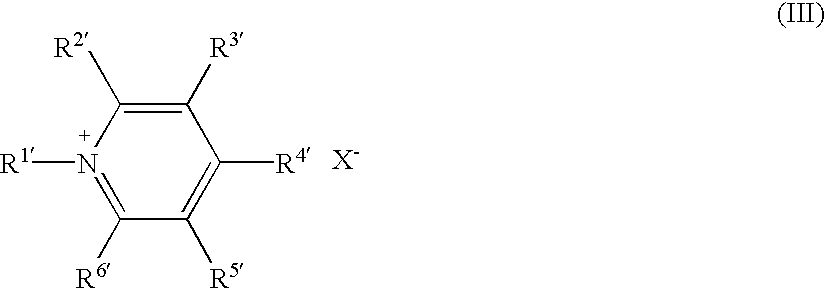Modified gelatin, and silver halide photographic emulsion and photographic light-sensitive material using the same
- Summary
- Abstract
- Description
- Claims
- Application Information
AI Technical Summary
Benefits of technology
Problems solved by technology
Method used
Image
Examples
example 2
[0450] The effects of the first emulsion in claim 3 and the modified gelatin of the present invention will be shown.
[0451] Gelatin 1-4 used for the dispersing medium in the emulsion preparation set forth below have the following characteristics:
[0452] Gelatin-1: Conventional alkali-processed ossein gelatin made from bovine bones. No --NH.sub.2 group in the gelatin was chemically modified. Gelatin-1 is the same as the original gelatin used in Example 1.
[0453] Gelatin-2: Gelatin formed by adding phthalic anhydride to an aqueous solution of gelatin-1 at 50.degree. C. and pH 9.0 to cause chemical reaction, removing the residual phthalic acid, and drying the resultant material. The ratio of the number of chemically modified --NH.sub.2 groups in the gelatin was 95%.
[0454] Gelatin-3: Gelatin formed by adding trimellitic anhydride to an aqueous solution of gelatin-1 at 50.degree. C. and pH 9.0 to cause chemical reaction, removing the residual trimellitic acid, and drying the resultant mate...
example 3
[0500] The effects of the second emulsion of claim 4 and the modified gelatin of the present invention will be shown. Host silver halide emulsions Em-A and Em-B were prepared by the following process.
[0501] (Preparation of Seed Emulsion A)
[0502] 1164 mL of an aqueous solution containing 0.017 g of KBr and 0.4 g of acid-processed gelatin having an average molecular weight of 20000 was stirred while being maintained at 30.degree. C. Then an AgNO.sub.3 (1.6 g) aqueous solution, KBr aqueous solution and acid-processed gelatin (2.1 g) of an average molecular weight of 20000 were added to the above solution by a triple jetting method for 30 minutes. The concentration of the AgNO.sub.3 solution was 0.2 mol / l. In this step, the silver potential was maintained at 15 mV to a saturated calomel electrode. A KBr aqueous solution was added to change the silver potential to -60 mV, and thereafter the temperature was raised to 75.degree. C. 21 g of succinated gelatin having an average molecular we...
example 5
[0613] The effect of the modified gelatin of the present invention in a multi-layer color light-sensitive material will now be shown.
[0614] The silver halide emulsion EM-A11 was prepared according to the following method.
[0615] (Preparation of EM-A11)
[0616] 1200 mL of an aqueous solution containing 1.0 g of low-molecular weight gelatin having a molecular weight of 15000 and 1.0 g of KBr was agitated while being maintained at 35.degree. C. Then, 30 mL of an aqueous solution containing 1.9 g of AgNO.sub.3 and 30 mL of an aqueous solution containing 1.5 g of KBr and 0.7 g of low-molecular weight gelatin having a molecular weight of 15000 were added by a double jetting method for 30 seconds to perform core formation. In this step, the excess concentration of KBr was maintained at a fixed value. Thereafter, 6 g of KBr was added, and the temperature of the solution was raised to 75.degree. C. to perform ripening. After completion of ripening, 35 g of succinated gelatin was added, and pH ...
PUM
| Property | Measurement | Unit |
|---|---|---|
| Fraction | aaaaa | aaaaa |
| Mass | aaaaa | aaaaa |
| Substance count | aaaaa | aaaaa |
Abstract
Description
Claims
Application Information
 Login to View More
Login to View More - R&D
- Intellectual Property
- Life Sciences
- Materials
- Tech Scout
- Unparalleled Data Quality
- Higher Quality Content
- 60% Fewer Hallucinations
Browse by: Latest US Patents, China's latest patents, Technical Efficacy Thesaurus, Application Domain, Technology Topic, Popular Technical Reports.
© 2025 PatSnap. All rights reserved.Legal|Privacy policy|Modern Slavery Act Transparency Statement|Sitemap|About US| Contact US: help@patsnap.com



